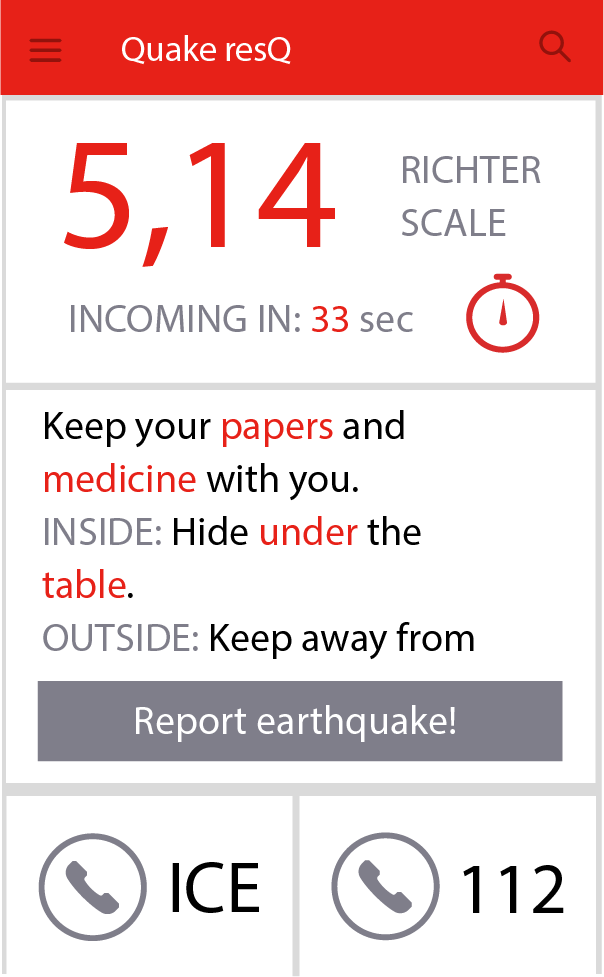Quake resQ – Low-Cost Earthquake Detection for Everyone

Challenge
Earthquakes can strike without warning – and while advanced countries like Japan have sophisticated seismic detection systems, their cost and infrastructure make them unattainable for many regions worldwide. Our goal was to create a low-cost, real-time earthquake detection and prediction system that could help protect communities in countries with weaker internet connectivity and limited resources. Beyond the technical challenge, this was also a social-entrepreneurship initiative – a project aimed not at profit, but at developing an accessible technology that could save lives and reduce the devastating impact of natural disasters.
The project began as a small student startup, combining our strongest skills – software and embedded systems development, which gradually grew into a complete platform. Quake resQ was our first-ever project, born as a small student startup combining our strongest skills – software and embedded systems development – which gradually grew into a complete platform. The core challenge: how to calculate an earthquake’s epicenter using GPS triangulation from both smartphones and fixed sensors, while filtering out noise from everyday movement and vibrations?
Solution
We developed Quake resQ, an intelligent platform that connects smartphones and microcontroller sensor boxes into a distributed seismic monitoring network. Each smartphone and sensor continuously measures ground vibrations through its accelerometer, sending anonymized data to a central server. The system then performs real-time triangulation using GPS coordinates to locate the earthquake’s epicenter.
Below is the original competition video we created during the early stages of the project. Although it’s a simple, student-made recording, it represents the very first public presentation of Quake resQ and captures how the idea started taking shape.
Noise reduction and firmware design
One of the key engineering challenges was teaching devices to distinguish between genuine seismic activity and common background noise – such as walking, vehicle traffic, or subway vibrations. To address this, we implemented a multi-layer filtering approach: The firmware on microcontrollers used rolling-average smoothing and adaptive thresholding to eliminate high-frequency motion typical for human or environmental noise. Each sensor continuously learned its local vibration baseline, automatically recalibrating to ignore repeated non-seismic patterns (like nearby construction or traffic).
On the server side, incoming signals from multiple nodes were compared in time windows – only correlated anomalies across several sensors were classified as potential seismic events.
Optimization for weak connectivity
A second challenge was ensuring reliable real-time data transfer in areas with unstable or low-bandwidth internet. To achieve this, we designed the communication protocol to use compressed data packets and local buffering: Each device temporarily stored readings offline and sent them in batches once a connection was available. Data transmission used lightweight JSON structures with delta encoding to minimize packet size. The backend supported fault-tolerant synchronization, so even intermittent connections wouldn’t break the network chain. This approach allowed the system to remain operational even in remote regions with 2G-level connectivity.
Collaboration and recognition
We presented the project at the Slovak Academy of Sciences, where it gained attention for its innovative, accessible use of distributed sensors. During development, we also established a partnership with Google, which was independently experimenting with the same detection principle – proving the global relevance and validity of our approach.
Beyond the technical milestones, Quake resQ was also recognized for its social and entrepreneurial impact. The project became a finalist and later winner of the Social Impact Award Slovakia 2015, was featured on the map of European social innovators, and received the LEAF Award for social innovation. These awards reflected the core mission behind Quake resQ – to apply innovation not for profit, but for the benefit of society, proving that technology can be a powerful tool for saving lives and empowering communities.
As part of the Social Impact Award, the project was also officially featured on their platform. You can view the original project listing here.

Outcome
After more than a year of development, we built a fully working prototype capable of detecting, triangulating, and visualizing seismic activity in real time. Quake resQ showcased how accessible hardware combined with thoughtfully designed software logic can form a resilient early-warning ecosystem. Its architecture demonstrated how distributed intelligence, efficient firmware, and adaptive data analysis can transform ordinary devices into cooperative safety sensors – bringing earthquake detection within reach of any region, regardless of its resources.

The interface provides users with real-time earthquake alerts.
The upper section displays the estimated magnitude and countdown until the shockwave arrives, while the lower section offers clear safety instructions based on the user’s environment.
Technologies
Quake resQ was built using a combination of web, server, and embedded technologies. The core platform relied on HTML, CSS, PHP, and MySQL for data management, visualization, and user interaction, while JavaScript and jQuery ensured responsive and dynamic front-end behavior.
The embedded part was developed in C++, focusing on microcontroller programming for data collection and pre-processing directly from accelerometers. Integration with the PayPal API supported online contributions, while methods like accelerometer data filtering, GPS triangulation, signal smoothing, and low-bandwidth optimization formed the backbone of the system’s analytical logic. Together, these technologies enabled a reliable, efficient, and interconnected earthquake detection network.

From our first project to a full-fledged software house.
Quake resQ was where it all started – a small student project proving that even simple ideas can make a real impact.
Today, we continue to build purposeful digital solutions with the same focus on innovation, reliability, and quality.
Get in touch →